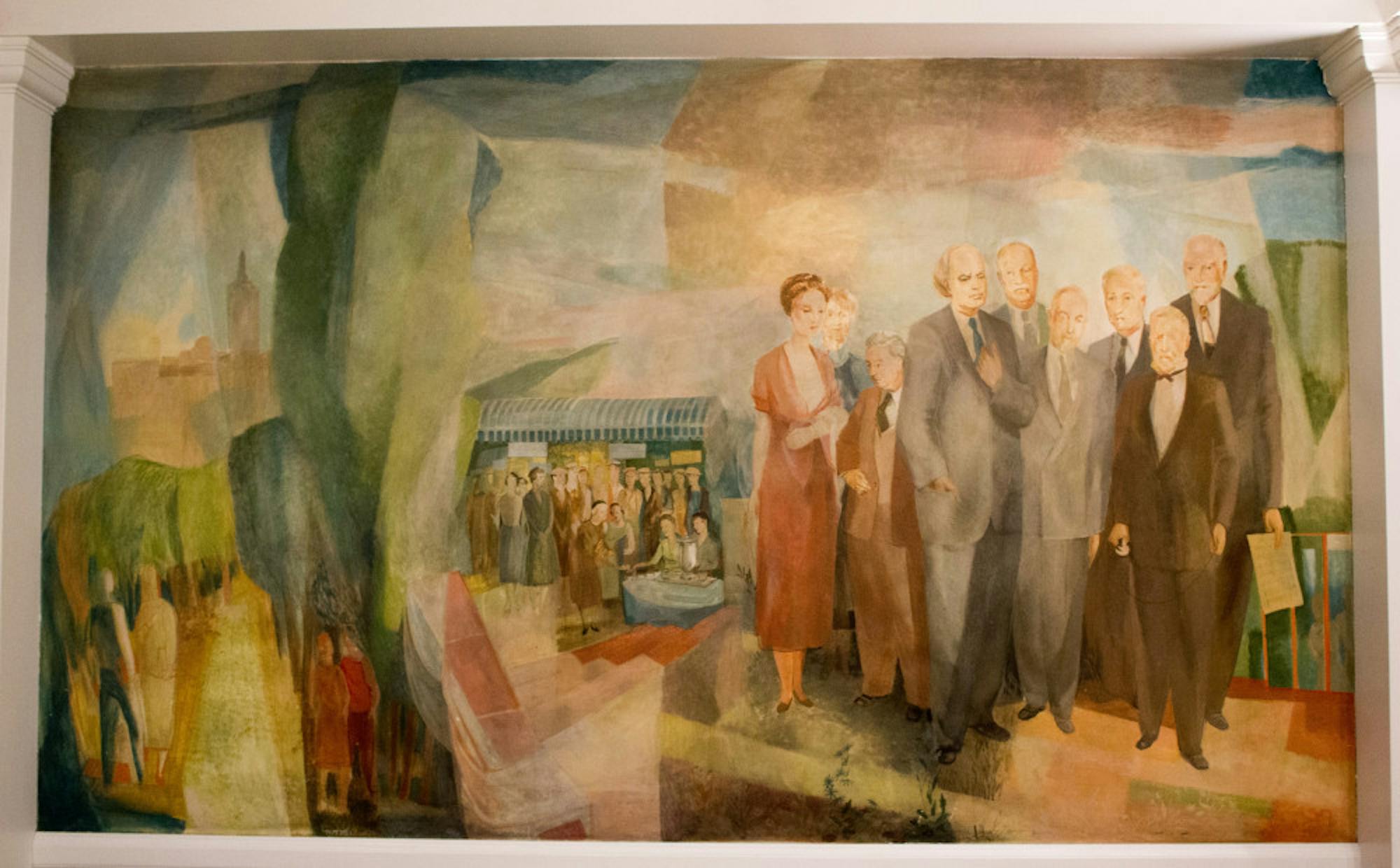Yesterday evening, the Consortium of Studies in Race, Colonialism, and Diaspora (RCD) and the Tufts University Art Galleries co-presented an open forum concerning the murals in Alumnae Lounge. According to speakers at the event, the future of the murals, which fail to depict any persons of racially marginalized communities, has been an ongoing topic of debate.
The Alumnae Lounge murals, completed in 1955 by Nathaniel Jacobson and Matthew Boyhan, were painted with egg tempera on canvas, according to a description written by Tufts Communications and Marketing Professional Laura Ferguson in a brochure passed out at the event. The brochure said the murals depict the founding of Tufts, including the construction of Ballou Hall on Walnut Hill and the founding members of the university, as well as notable alumni and leadership from the time the mural was painted. Critics of the mural have taken issue because, with the exception of some white women, the mural solely portrays white, Protestant men, according to Andrew McClellan, professor of art history and museum studies advisor and one of the speakers at the event.
Daniel McCusker, senior lecturer and head of performance in the Department of Drama and Dance, moderated the forum. The discussion began with three presentations by members of the Tufts community, who all shared different insights into the history of the mural, its issues regarding diversity and Tufts’ image, and what different courses of action could signify within the broader conversation of art history and historical preservation.
Katrina Moore, director of the Africana Center, introduced some of the issues surrounding the mural’s exclusion of people of color. She noted that Tufts’ emphasis on diversity, especially on its website, does not agree with the mural’s depiction of solely white founders, leaders, students and alumni, and makes the Alumnae Lounge feel alienating.
Adriana Zavala, associate professor of art history and director of the RCD, briefly discussed some of the issues in the mural with regard to erased cultural histories. She explained that an RCD dinner last November engendered further conversation about the murals in the context of the white supremacist rally in Charlottesville last summer and issues of representation and monuments.
Zavala then introduced first-years Sung-Min Kim and Maxine Bell and sophomore Ryan Tam, students from her fall 2017 class, The Latinx Presence in Art And Visual Culture. Kim, Bell and Tam discussed their final project for the class, which involved digitally adding symbolic "stickers" to the murals in the Alumnae Lounge to draw attention to the erased histories in the mural and invite further research into those histories.
“We were really interested in the Alumnae Lounge mural because it was so immediate to the community, and [it is] preserving an antiquated narrative that we thought was not supported in this community,” Kim said.
McClellan then discussed the potential removal of the mural from an art history standpoint, arguing that completely tearing them down might needlessly destroy a historical object. He discussed the difficulties in treating historical objects.
“What survives from the past, and what needs to be done with that past? How do you deal with the past when ideas change? When people change? When society changes?" he asked. "My instinct … as an art historian is to want to intervene in some way that does not consign these objects to oblivion.”
Adrienne Pruitt, collections management archivist at the Tufts Digital Collections and Archives, described the degree to which the university administration at the time influenced the mural's production.
“While theoretically, Nathaniel Jacobson and Matthew Boyhan had free artistic reign over who to include in the murals, the administration and alumni had a heavy hand in the choices that were made,” Pruitt explained.
The conversation then opened to the audience. Speakers and audience members offered potential solutions to the issues the murals present, trying to balance preserving history and lessons about exclusion while also representing the Tufts community. Suggestions included taking it down and creating a new mural, though the survival of the original mural was a point of contention, as its medium and age may not allow for its preservation after removing it. Other suggestions included temporarily covering it, removing it and adding a plaque to explain the community’s concerns regarding it, or keeping it and adding wall labels or more student work to preserve a teaching moment about historical erasure.
University hosts open forum on race, representation in Alumnae Lounge murals

The mural painted on the walls of the Alumnae Lounge is pictured.





